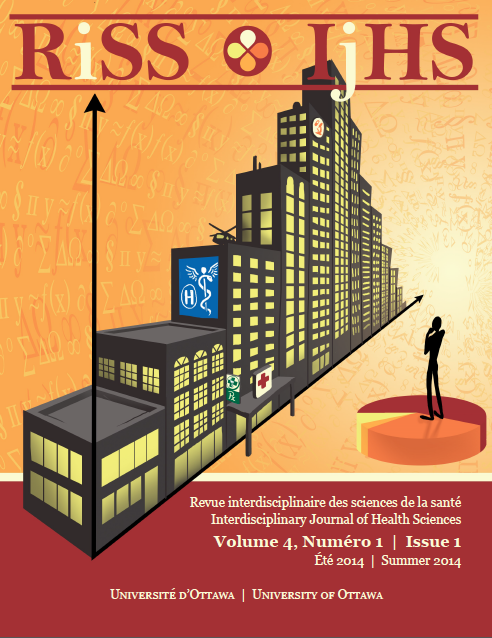Parental and Peer Influences on Adolescent Smoking: A Literature Review
DOI :
https://doi.org/10.18192/riss-ijhs.v4i1.1218Mots-clés :
Adolescence, fumer, influence des pairs, sélection des pairs, influenceRésumé
La cigarette est largement acceptée comme un comportement négatif pour la santé, associé à de nombreux risques graves. Le tabagisme chez les adolescents est d’un intérêt particulier du point de vue de la santé publique, alors même que l’initiation au tabagisme à l’adolescence se trouve associée à des taux plus élevés de dépendance à l’âge adulte. Cette revue de la littérature examinera l’influence des réseaux de soutien social, en particulier les parents et les pairs, sur l’initiation au tabagisme et sur sa progression chez les adolescents. L’influence des réseaux de soutien social opère principalement à travers la théorie de l’apprentissage social, selon laquelle les adolescents imitent le comportement de ceux qui sont dans leur réseau social. La littérature suggère que, tandis que les parents ont plus d’influence chez les jeunes adolescents, les pairs deviennent la principale source d’influence chez les adolescents plus âgés, en raison de ces phénomènes bien connus que sont la sélection par les pairs et l’influence des pairs. Les parents peuvent influer positivement sur le comportement des adolescents face au tabagisme grâce à une communication efficace et au maintien d’une relation saine parent-enfant. Les pairs peuvent également influencer positivement le comportement des fumeurs par les mêmes mécanismes d’influence et de sélection par les pairs. La connaissance de la façon dont les parents et les pairs incitent les adolescents à commencer de fumer, et à continuer, peut aider à l’élaboration de programmes de santé publique qui ciblent ce comportement à haut risque.
Références
Bandura, A. (Writer), & Davidson Films Inc. (Producer). (2003). Bandura’s social cognitive theory: An introduction [Video File]. Retrieved from http://ediv.alexanderstreet.com.proxy.bib.uottawa.ca/View/1641092
Barnes, G., Hoffman, J., Welte, J., Farrell, M., & Dintcheff, B. (2007). Adolescents’ time use: Effects on substance use, delinquency and sexual activity. Journal of Youth and Adolescence, 36(5), 697-710. doi: 10.1007/s10964-006-9075-0
Brady, S. S., Morrell, H. E. R., Song, A. V., & Halpern-Felsher, B. L. (2013). Longitudinal study of adolescents’ attempts to promote and deter friends’ smoking behavior. Journal of Adolescent Health, 53(6), 772-777. doi: 10.1016/j.jadohealth.2013.06.022
Bricker, J. B., Peterson, A. V., Jr., Leroux, B. G., Andersen, M. R., Rajan, K. B., & Sarason, I. G. (2006). Prospective prediction of children’s smoking transitions: Role of parents’ and older siblings’ smoking. Addiction, 101(1), 128-136. doi: 10.1111/j.1360-0443.2005.01297.x
Cole, A. G., Leatherdale, S. T., & Burkhalter, R. (2013). An examination of different smoking patterns among Canadian youth: New insight for tobacco control programming. Addictive Behaviors, 38(3), 1610-1615. doi: 10.1016/j.addbeh.2012.10.004
Ennett, S. T., & Bauman, K. E. (1994). The contribution of influence and selection to adolescent peer group homogeneity: The case of adolescent cigarette smoking. Journal of Personality and Social Psychology, 67(4), 653-663. doi: 10.1037/0022-3514.67.4.653
Griffin, K. W., Botvin, G. J., Doyle, M. M., Diaz, T., & Epstein, J. A. (1999). A six-year follow-up study of determinants of heavy cigarette smoking among high-school seniors. Journal of Behavioral Medicine, 22(3), 271-284.
Hall, J. A., & Valente, T. W. (2007). Adolescent smoking networks: The effects of influence and selection on future smoking. Addictive Behaviors, 32(12), 3054-3059. doi: 10.1016/j.addbeh.2007.04.008
Harakeh, Z., & Vollebergh, W. A. M. (2012). The impact of active and passive peer influence on young adult smoking: An experimental study. Drug and Alcohol Dependence, 121(3), 220-223. doi: 10.1016/j.drugalcdep.2011.08.029
Hoffman, B. R., Monge, P. R., Chou, C. P., & Valente, T. W. (2007). Perceived peer influence and peer selection on adolescent smoking. Addictive Behaviors, 32(8), 1546-1554. doi: 10.1016/j.addbeh.2006.11.016
Janz, T. (2012, June). Health at a glance: Current smoking trends. Retrieved from http://www.statcan.gc.ca/pub/82-624-x/2012001/article/11676-eng.htm
Maxwell, K. A. (2002). Friends: The role of peer influence across adolescent risk behaviors. Journal of Youth and Adolescence, 31(4), 267-277.
Metzger, A., Wakschlag, L. S., Anderson, R., Darfler, A., Price, J., Flores, Z., & Mermelstein, R. (2013). Information management strategies within conversations about cigarette smoking: Parenting correlates and longitudinal associations with teen smoking. Developmental Psychology, 49 (8), 1565-1578. doi: 10.1037/a0030720
Miller, T. Q., & Volk, R. J. (2002). Family relationships and adolescent cigarette smoking: Results from a national longitudinal survey. Journal of Drug Issues, 32(3), 945-972.
Peterson, A. V., Leroux, B. G., Bricker, J., Kealey, K. A., Marek, P. M., Sarason, I. G., & Andersen, M. R. (2006). Nine-year prediction of adolescent smoking by number of smoking parents. Addictive Behaviors, 31(5), 788-801. doi:10.1016/j.addbeh.2005.06.003
Scal, P., Ireland, M., & Borowsky, I. W. (2003). Smoking among American adolescents: A risk and protective factor analysis. Journal of Community Health, 28(2), 79-97.
Simons-Morton, B. G. (2004). The protective effect of parental expectations against early adolescent smoking initiation. Health Education Research, 19(5), 561-569. doi: 10.1093/her/cyg071
Simons-Morton, B., Haynie, D., Crump, A., Eitel, P., & Saylor, K. (2001). Peer and parent influences on smoking and drinking among early adolescents. Health Education & Behavior, 28(1), 95-107. doi: 10.1177/109019810102800109
Urberg, K. A., Shiang-Jeou, S., & Liang, J. (1990). Peer influence in adolescent cigarette smoking. Addictive Behaviors, 15(3), 247-255. doi: 10.1016/0306-4603(90)90067-8
Vitaro, F., Wanner, B., Brendgen, M., Gosselin, C., & Gendreau, P. L. (2004). Differential contribution of parents and friends to smoking trajectories during adolescence. Addictive Behaviors, 29(4), 831-835. doi: 10.1016/j.addbeh.2004.02.018
World Health Organization. (2014). Prevalence of tobacco use. Retrieved from http://www.who.int/gho/tobacco/use/en/
Téléchargements
Publié-e
Numéro
Rubrique
Licence
- Tous les auteurs dont l’article est publié dans la RISS en conserveront les droits.
- Les auteurs accordent à la RISS le droit d’être la première à publier les articles qui lui sont soumis.
- Tous les articles publiés dans la RISS sont autorisés en vertu d’une licence Creative Commons Attribution à être circulé si les auteurs et la revue de la publication originale sont reconnus.
- La RISS est publiée en ligne et imprimée. La RISS n’est pas responsable de l’utilisation non autorisée du contenu publié sous forme électronique ou imprimée.
- La RISS retient les droits de distribution de tout le contenu.
- Les auteurs, et non la RISS, sont responsables d’avoir obtenu les permissions nécessaires concernant les travaux cités.


